Page 28 SKODA OCTAVIA 2005 1.G / (1U) Owner's Manual
[x] Cancel search | Manufacturer: SKODA, Model Year: 2005, Model line: OCTAVIA, Model: SKODA OCTAVIA 2005 1.G / (1U)Pages: 315, PDF Size: 11.8 MB
Page 232 of 315
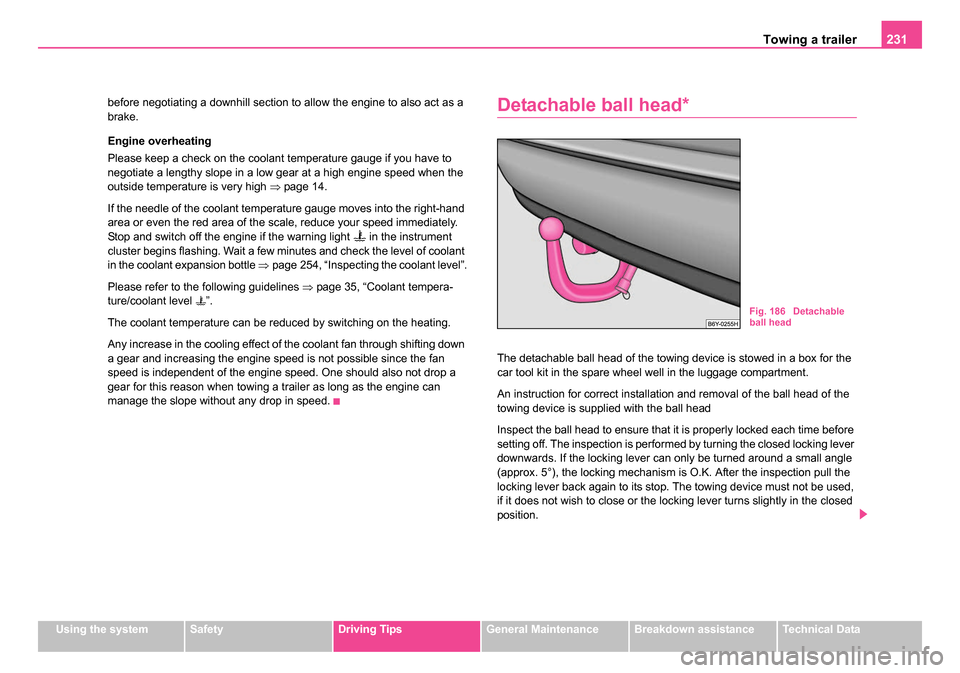
Towing a trailer231
Using the systemSafetyDriving TipsGeneral MaintenanceBreakdown assistanceTechnical Data
before negotiating a downhill section to allow the engine to also act as a
brake.
Engine overheating
Please keep a check on the coolant temperature gauge if you have to
negotiate a lengthy slope in a low gear at a high engine speed when the
outside temperature is very high
⇒page 14.
If the needle of the coolant temperature gauge moves into the right-hand
area or even the red area of the scale, reduce your speed immediately.
Stop and switch off the engine if the warning light
in the instrument
cluster begins flashing. Wait a few minutes and check the level of coolant
in the coolant expansion bottle ⇒page 254, “Inspecting the coolant level”.
Please refer to the following guidelines ⇒page 35, “Coolant tempera-
ture/coolant level ”.
The coolant temperature can be reduced by switching on the heating.
Any increase in the cooling effect of the coolant fan through shifting down
a gear and increasing the engine speed is not possible since the fan
speed is independent of the engine speed. One should also not drop a
gear for this reason when towing a trailer as long as the engine can
manage the slope without any drop in speed.
Detachable ball head*
The detachable ball head of the towing device is stowed in a box for the
car tool kit in the spare wheel well in the luggage compartment.
An instruction for correct installation and removal of the ball head of the
towing device is supplied with the ball head
Inspect the ball head to ensure that it is properly locked each time before
setting off. The inspection is performed by turning the closed locking lever
downwards. If the locking lever can only be turned around a small angle
(approx. 5°), the locking mechanism is O.K. After the inspection pull the
locking lever back again to its stop. The towing device must not be used,
if it does not wish to close or the locking lever turns slightly in the closed
position.
Fig. 186 Detachable
ball head
s24s.book Page 231 Thursday, November 24, 2005 12:27 PM
Page 233 of 315

Towing a trailer
232
WARNING
Do not use any aids or tools for installing or removing the ball
head. This might result in damage to the locking mechanism to the
extent that the safety of the towing device is no longer assured -
risk of an accident.
Note
•Do not carry out any modifications or repairs to the ball head or to any
other components on the towing device.
•Contact a specialist garage if you encounter any problems using the
device.
•Never unlock the ball head with a trailer coupled to it.
•You should take off the ball head if you drive without towing a trailer.
Inspect whether the end cover properly seals off the mounting shaft.
•Remove the ball head beforehand if you wish to clean your vehicle
using a steam jet. Ensure that the end cover properly seals the mounting
shaft.
•It is recommended to wear gloves when installing and removing.
s24s.book Page 232 Thursday, November 24, 2005 12:27 PM
Page 234 of 315
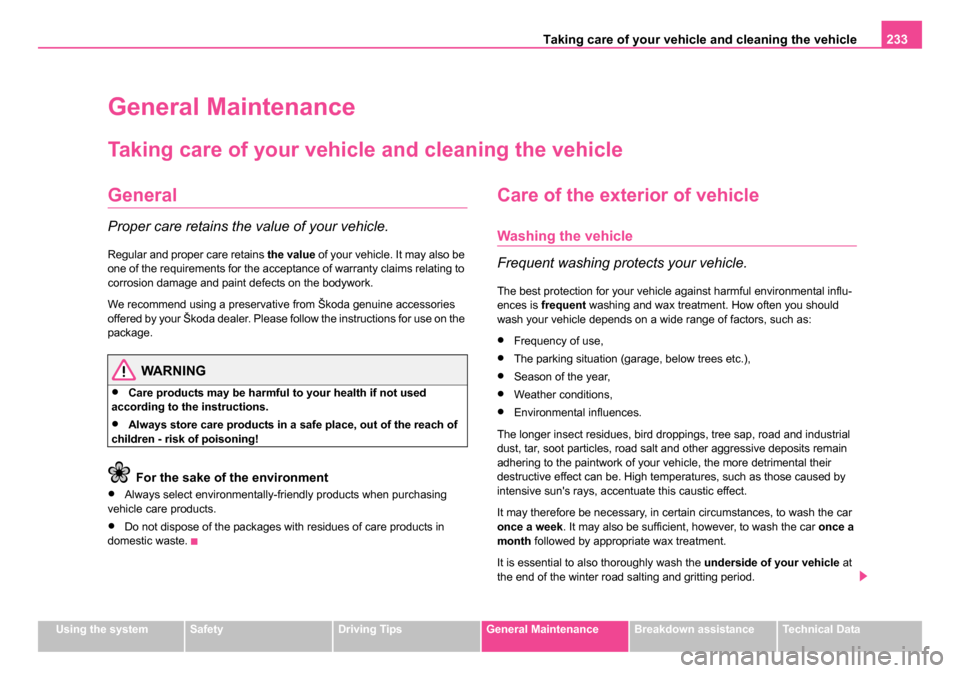
Taking care of your vehicle and cleaning the vehicle 233
Using the systemSafetyDriving TipsGeneral MaintenanceBreakdown assistanceTechnical Data
General Maintenance
Taking care of your vehicle and cleaning the vehicle
General
Proper care retains the value of your vehicle.
Regular and proper care retains the value of your vehicle. It may also be
one of the requirements for the acceptance of warranty claims relating to
corrosion damage and paint defects on the bodywork.
We recommend using a preservative from Škoda genuine accessories
offered by your Škoda dealer. Please follow the instructions for use on the
package.
WARNING
•Care products may be harmful to your health if not used
according to the instructions.
•Always store care products in a safe place, out of the reach of
children - risk of poisoning!
For the sake of the environment
•Always select environmentally-friendly products when purchasing
vehicle care products.
•Do not dispose of the packages with residues of care products in
domestic waste.
Care of the exterior of vehicle
Washing the vehicle
Frequent washing protects your vehicle.
The best protection for your vehicle against harmful environmental influ-
ences is frequent washing and wax treatment. How often you should
wash your vehicle depends on a wide range of factors, such as:
•Frequency of use,
•The parking situation (garage, below trees etc.),
•Season of the year,
•Weather conditions,
•Environmental influences.
The longer insect residues, bird droppings, tree sap, road and industrial
dust, tar, soot particles, road salt and other aggressive deposits remain
adhering to the paintwork of your vehicle, the more detrimental their
destructive effect can be. High temperatures, such as those caused by
intensive sun's rays, accentuate this caustic effect.
It may therefore be necessary, in certain circumstances, to wash the car
once a week . It may also be sufficient, however, to wash the car once a
month followed by appropriate wax treatment.
It is essential to also thoroughly wash the underside of your vehicle at
the end of the winter road salting and gritting period.
s24s.book Page 233 Thursday, November 24, 2005 12:27 PM
Page 235 of 315
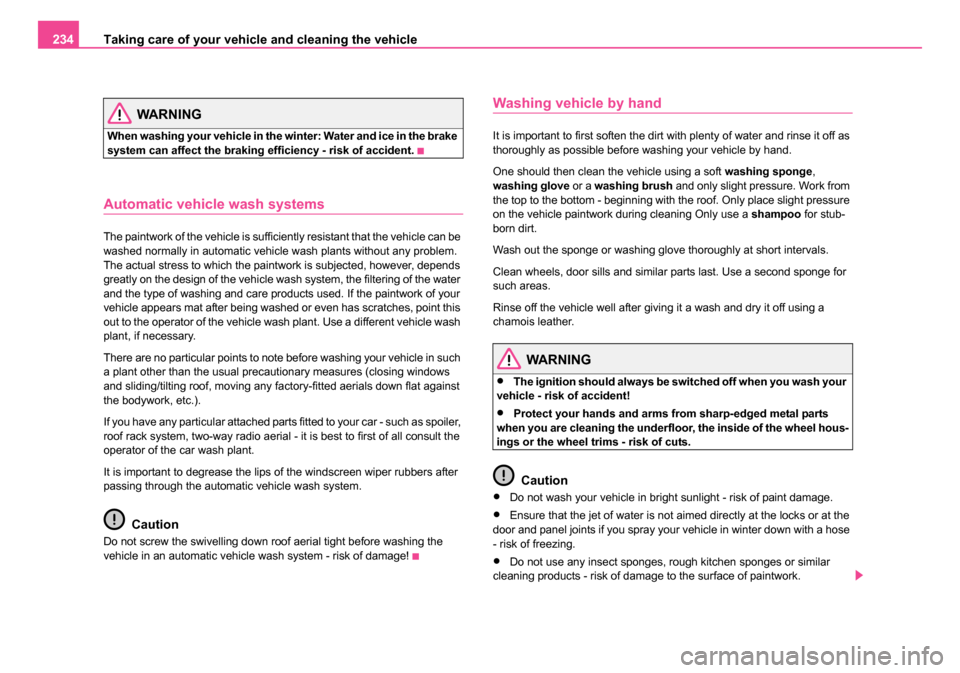
Taking care of your vehicle and cleaning the vehicle
234
WARNING
When washing your vehicle in the winter: Water and ice in the brake
system can affect the braking efficiency - risk of accident.
Automatic vehicle wash systems
The paintwork of the vehicle is sufficiently resistant that the vehicle can be
washed normally in automatic vehicle wash plants without any problem.
The actual stress to which the paintwork is subjected, however, depends
greatly on the design of the vehicle wash system, the filtering of the water
and the type of washing and care products used. If the paintwork of your
vehicle appears mat after being washed or even has scratches, point this
out to the operator of the vehicle wash plant. Use a different vehicle wash
plant, if necessary.
There are no particular points to note before washing your vehicle in such
a plant other than the usual precautionary measures (closing windows
and sliding/tilting roof, moving any factory-fitted aerials down flat against
the bodywork, etc.).
If you have any particular attached parts fitted to your car - such as spoiler,
roof rack system, two-way radio aerial - it is best to first of all consult the
operator of the car wash plant.
It is important to degrease the lips of the windscreen wiper rubbers after
passing through the automatic vehicle wash system.
Caution
Do not screw the swivelling down roof aerial tight before washing the
vehicle in an automatic vehicle wash system - risk of damage!
Washing vehicle by hand
It is important to first soften the dirt with plenty of water and rinse it off as
thoroughly as possible before washing your vehicle by hand.
One should then clean the vehicle using a soft washing sponge,
washing glove or a washing brush and only slight pressure. Work from
the top to the bottom - beginning with the roof. Only place slight pressure
on the vehicle paintwork during cleaning Only use a shampoo for stub-
born dirt.
Wash out the sponge or washing glove thoroughly at short intervals.
Clean wheels, door sills and similar parts last. Use a second sponge for
such areas.
Rinse off the vehicle well after giving it a wash and dry it off using a
chamois leather.
WARNING
•The ignition should always be switched off when you wash your
vehicle - risk of accident!
•Protect your hands and arms from sharp-edged metal parts
when you are cleaning the underfloor, the inside of the wheel hous-
ings or the wheel trims - risk of cuts.
Caution
•Do not wash your vehicle in bright sunlight - risk of paint damage.
•Ensure that the jet of water is not aimed directly at the locks or at the
door and panel joints if you spray your vehicle in winter down with a hose
- risk of freezing.
•Do not use any insect sponges, rough kitchen sponges or similar
cleaning products - risk of damage to the surface of paintwork.
s24s.book Page 234 Thursday, November 24, 2005 12:27 PM
Page 236 of 315
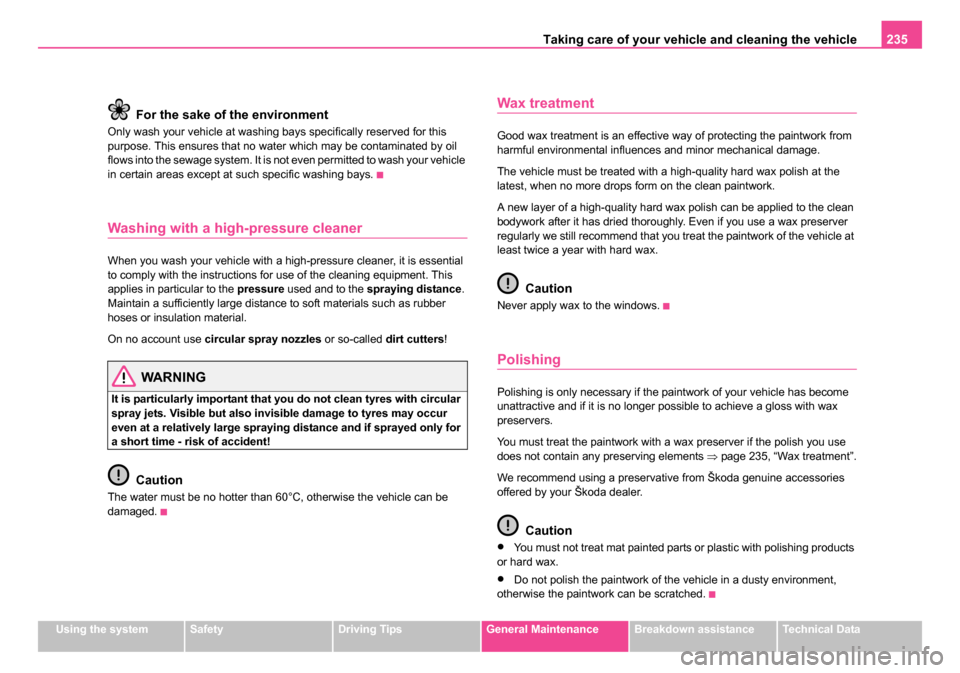
Taking care of your vehicle and cleaning the vehicle 235
Using the systemSafetyDriving TipsGeneral MaintenanceBreakdown assistanceTechnical Data
For the sake of the environment
Only wash your vehicle at washing bays specifically reserved for this
purpose. This ensures that no water which may be contaminated by oil
flows into the sewage system. It is not even permitted to wash your vehicle
in certain areas except at such specific washing bays.
Washing with a high-pressure cleaner
When you wash your vehicle with a high-pressure cleaner, it is essential
to comply with the instructions for use of the cleaning equipment. This
applies in particular to the pressure used and to the spraying distance .
Maintain a sufficiently large distance to soft materials such as rubber
hoses or insulation material.
On no account use circular spray nozzles or so-called dirt cutters!
WARNING
It is particularly important that you do not clean tyres with circular
spray jets. Visible but also invisible damage to tyres may occur
even at a relatively large spraying distance and if sprayed only for
a short time - risk of accident!
Caution
The water must be no hotter than 60°C, otherwise the vehicle can be
damaged.
Wax treatment
Good wax treatment is an effective way of protecting the paintwork from
harmful environmental influences and minor mechanical damage.
The vehicle must be treated with a high-quality hard wax polish at the
latest, when no more drops form on the clean paintwork.
A new layer of a high-quality hard wax polish can be applied to the clean
bodywork after it has dried thoroughly. Even if you use a wax preserver
regularly we still recommend that you treat the paintwork of the vehicle at
least twice a year with hard wax.
Caution
Never apply wax to the windows.
Polishing
Polishing is only necessary if the paintwork of your vehicle has become
unattractive and if it is no longer possible to achieve a gloss with wax
preservers.
You must treat the paintwork with a wax preserver if the polish you use
does not contain any preserving elements ⇒page 235, “Wax treatment”.
We recommend using a preservative from Škoda genuine accessories
offered by your Škoda dealer.
Caution
•You must not treat mat painted parts or plastic with polishing products
or hard wax.
•Do not polish the paintwork of the vehicle in a dusty environment,
otherwise the paintwork can be scratched.
s24s.book Page 235 Thursday, November 24, 2005 12:27 PM
Page 237 of 315

Taking care of your vehicle and cleaning the vehicle
236
Chrome parts
First clean the chrome parts with a damp clotch and then polish them with
a soft, dry cloth. If it does not prove to be adequate, use a chrome care
product from Škoda original accessories.
Caution
Do not polish the chrome parts in a dusty environment, otherwise they can
be scratched.
Paint damage
Slight damage to paintwork such as scratches, scuffs or traces of chip
damage must be touched up immediately with paint (Škoda painting pen)
before any corrosion can result. You can of course have this work carried
out by a Škoda dealer.
Škoda dealers have a range of matching touch-up pens or spray cans
available in the colour of your vehicle.
The paint number of the original paintwork of your vehicle is indicated on
the vehicle data sticker ⇒page 303.
Any corrosion which has already have formed must be removed thor-
oughly. Apply a corrosion protection primer and then the paint to the
affected point. You can of course have this work carried out by a Škoda
dealer.
Plastic parts
External plastic parts are cleaned by normal washing. Plastic parts and
synthetic leather can also be treated with special solvent-free plastic
cleaning agents if a damp cloth is not sufficient. Paint care products are
not suitable for plastic parts.
Caution
Solvent-free cleaners attack the material and can damage it.
Windows
Only use a plastic ice scraper for removing snow and ice from the
windows and mirrors. You should not move the ice scraper forward and
backward but in one direction on the window which you are cleaning in
order to avoid any damage to the surface of the glass.
You can best remove residues of rubber, oil, grease, wax or silicone by
using a special window cleaner or a special silicone remover.
You should also clean the windows regularly from the inside.
Do not use window leathers which you have used to polish the vehicle
body to dry off the windows. Residues of preservatives in the window
leather can dirty the window and reduce visibility.
Do not affix any stickers over the inside of the rear window to avoid
damage to the heating elements of the rear window heater .
We recommend using a preservative from Škoda genuine accessories
offered by your Škoda dealer.
s24s.book Page 236 Thursday, November 24, 2005 12:27 PM
Page 238 of 315

Taking care of your vehicle and cleaning the vehicle 237
Using the systemSafetyDriving TipsGeneral MaintenanceBreakdown assistanceTechnical Data
Caution
Never remove snow or ice from the glass parts with warm or hot water -
risk of formation of cracks in the glass!
The headlight lenses
Please do not use any aggressive cleaning or chemical solvent products
- risk of damage to the plastic lenses Please use soap and clean warm
water.
Caution
Never wipe the headlights dry and do not use any sharp objects for
cleaning the plastic lenses, this may result in damage to the protective
paintwork and consequently in formation of cracks on the headlight
lenses, e.g through effect of chemical products.
Door and window seals
The rubber seals on the doors, boot lid, bonnet, sliding roof and windows
remain supple and last longer if you treat them from time to time with a
rubber care product (e.g. silicone spray). You also avoid premature wear
of the seals and prevent leakages in this way. It is also easier to open the
doors. Rubber seals which are well cared for also do not stick together in
cold winter weather.
Locks
We recommend that you use the spray from Škoda original accessories
with regreasing and anticorrosive effect for de-icing locks.
Note
When washing your vehicle, ensure that as little water as possible gets
into the locks.
Wheels
Steel wheels
You should also thoroughly wash the wheels and wheel trims when giving
your vehicle its regular wash. This prevents any brake dust, dirt and road
salt from sticking to the wheel hubs. You can remove stubborn brake abra-
sion adhering to the wheels with an industrial cleaner. Touch up any
damage to the paintwork on the wheels before rust is able to form.
Light alloy wheels
Regular care of light alloy wheels is necessary in order to retain their
decorative appearance over long periods. It is particularly important to
remove any road salt and brake abrasion from light alloy wheels every two
weeks, otherwise the surface will suffer. Wash thoroughly and then treat
the wheels with a protective product for light alloy wheels which does not
contain any acidic components. You should provide the wheel hubs with
a hard wax layer every three months. You must not use any products
which cause abrasion when treating the wheel hubs. Any damage to the
paint layer on the wheel hubs must be touched up immediately.
We recommend using a preservative from Škoda genuine accessories
offered by your Škoda dealer.
s24s.book Page 237 Thursday, November 24, 2005 12:27 PM
Page 239 of 315

Taking care of your vehicle and cleaning the vehicle
238
WARNING
One should remember when cleaning the wheels that moisture, ice
and road salt may adversely affect braking efficiency - risk of an
accident!
Note
Severe layers of dirt on the wheels can also result in wheel imbalance.
This may show itself in the form of a wheel vibration which is transmitted
to the steering wheel which, in certain circumstances, can cause prema-
ture wear of the steering. This means it is necessary to remove the dirt.
Underbody protection
The underside of your vehicle is protected for life against chemical and
mechanical influences.
One cannot, however, completely rule out damage to the protective layer
when driving so we recommend that you inspect the protective layer on
the underside of your vehicle and on the chassis at certain intervals - this
is best done at the beginning and end of the winter - and to touch up any
damaged areas.
Škoda dealers have suitable spray products available as well as the
necessary equipment and are familiar with the instructions for its use. It is
therefore best to have such touch-up work or additional corrosion protec-
tion measures carried out by a Škoda dealer.
WARNING
Never use additional underbody protection or corrosion-protection
agents for the exhaust pipes, catalytic converters or heat shields.
Such substances might ignite when driving - risk of fire!
Protection of hollow spaces
All the cavities of your vehicle which are at risk from corrosion are
protected for life by a layer of protective wax applied in the factory.
This wax protection does not require to be inspected or re-treated. Please
remove any small amount of wax which flows out of the cavities at high
temperatures with a plastic scraper and clean the spot using petroleum
cleaner.
WARNING
Safety and environmental prot ection regulations should be
observed when using petroleum cleaner to remove wax - a risk of
fire!
Engine compartment
Good corrosion protection is very important, particularly in winter when
one often drives over its salt-strewn roads. One should therefore clean the
engine compartment before and after the salt spreading period and treat
with preservative in order to prevent the salt from being destructive.
Škoda dealers have the cleaning agents and preservatives recommended
by the manufacturer and also the required equipment.
WARNING
•It is necessary to observe the guidelines given in the chapter
before working on the engine compartment ⇒page 248.
•Let the engine cool down before cleaning the engine compart-
ment.
s24s.book Page 238 Thursday, November 24, 2005 12:27 PM
Page 240 of 315

Taking care of your vehicle and cleaning the vehicle 239
Using the systemSafetyDriving TipsGeneral MaintenanceBreakdown assistanceTechnical Data
Caution
•Engine cleaning may only be undertaken when the ignition is off.
•It is recommended to cover the generator before washing the engine
compartment.
For the sake of the environment
The dirty water produced by washing the engine has washed away petrol,
and residues of grease and oil and should therefore be cleaned by an oil
separator. This is why engine washing should only be undertaken in a
specialist garage or at a fueling station (when these are fitted with the
required equipment).
Care of the interior of vehicle
Plastic parts, artificial leather and cloths
You can clean plastic parts and artificial leather with a moist cloth. You
should only treat such parts with special solvent-free plastic cleaning
and care products it does prove to be adequate.
Upholstery cloth and cloth trim on the doors, luggage compartment cover,
headliner etc. are best treated with special cleaning products, using if
necessary a dry foam and a soft sponge or brush.
We recommend using a cleaning product from Škoda genuine accesso-
ries offered by your Škoda dealer.
Caution
Solvent-free cleaners attack the material and can damage it.
Fabric covers of electrically heated seats
Do not clean the seat covers wet as this may result in damage to the seat
heating system.
Clean such covers using special agents, for example dry foam.
Natural leather
Natural leather requires quite particular care and attention.
Leather should be treated from time to time according the
following guidelines depending on how much it is used.
Normal cleaning
– Clean soiled areas of the leather with slightly moistened cotton or woollen cloth.
Severe soiling
– Clean severely soiled areas with a cloth dipped in a mild soapy solution (2 spoonfuls of pH-neutral soap to 1 litre of
water).
– Ensure that the leather is not soaked through at any point and that no water gets into the stitching of the seams.
– Dry off the leather with a soft, dry cloth.
s24s.book Page 239 Thursday, November 24, 2005 12:27 PM
Page 241 of 315
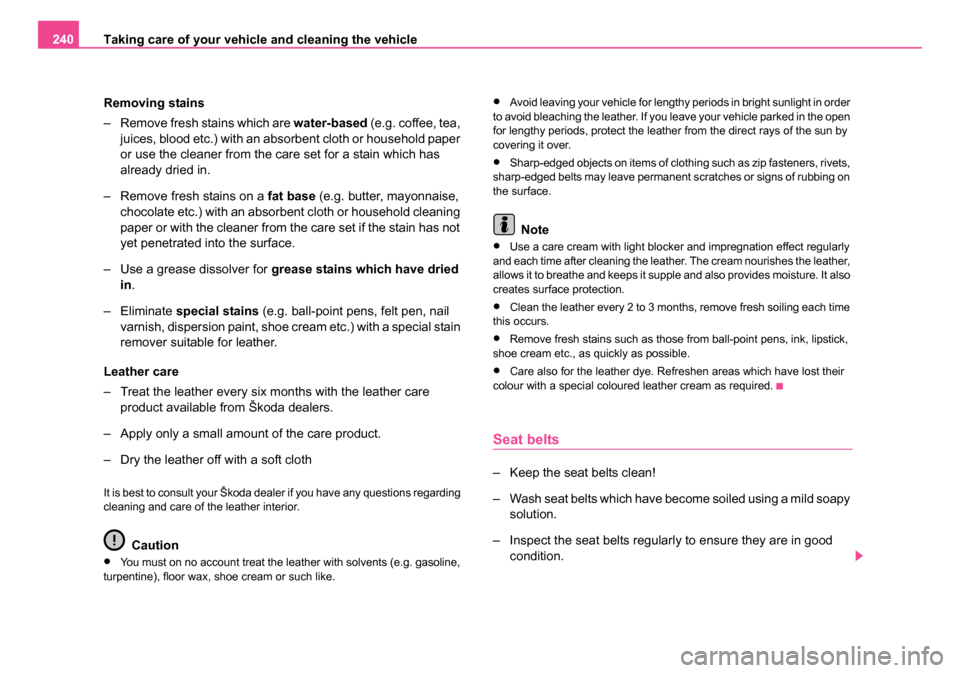
Taking care of your vehicle and cleaning the vehicle
240
Removing stains
– Remove fresh stains which are water-based (e.g. coffee, tea, juices, blood etc.) with an absorbent cloth or household paper
or use the cleaner from the care set for a stain which has
already dried in.
– Remove fresh stains on a fat base (e.g. butter, mayonnaise,
chocolate etc.) with an absorbent cloth or household cleaning
paper or with the cleaner from the care set if the stain has not
yet penetrated into the surface.
– Use a grease dissolver for grease stains which have dried
in .
–Eliminate special stains (e.g. ball-point pens, felt pen, nail
varnish, dispersion paint, shoe cream etc.) with a special stain
remover suitable for leather.
Leather care
– Treat the leather every six months with the leather care product available from Škoda dealers.
– Apply only a small amount of the care product.
– Dry the leather off with a soft cloth
It is best to consult your Škoda dealer if you have any questions regarding
cleaning and care of the leather interior.
Caution
•You must on no account treat the leather with solvents (e.g. gasoline,
turpentine), floor wax, shoe cream or such like.
•Avoid leaving your vehicle for lengthy periods in bright sunlight in order
to avoid bleaching the leather. If you leave your vehicle parked in the open
for lengthy periods, protect the leather from the direct rays of the sun by
covering it over.
•Sharp-edged objects on items of clothing such as zip fasteners, rivets,
sharp-edged belts may leave permanent scratches or signs of rubbing on
the surface.
Note
•Use a care cream with light blocker and impregnation effect regularly
and each time after cleaning the leather. The cream nourishes the leather,
allows it to breathe and keeps it supple and also provides moisture. It also
creates surface protection.
•Clean the leather every 2 to 3 months, remove fresh soiling each time
this occurs.
•Remove fresh stains such as those from ball-point pens, ink, lipstick,
shoe cream etc., as quickly as possible.
•Care also for the leather dye. Refreshen areas which have lost their
colour with a special coloured leather cream as required.
Seat belts
– Keep the seat belts clean!
– Wash seat belts which have become soiled using a mild soapy solution.
– Inspect the seat belts regularly to ensure they are in good condition.
s24s.book Page 240 Thursday, November 24, 2005 12:27 PM